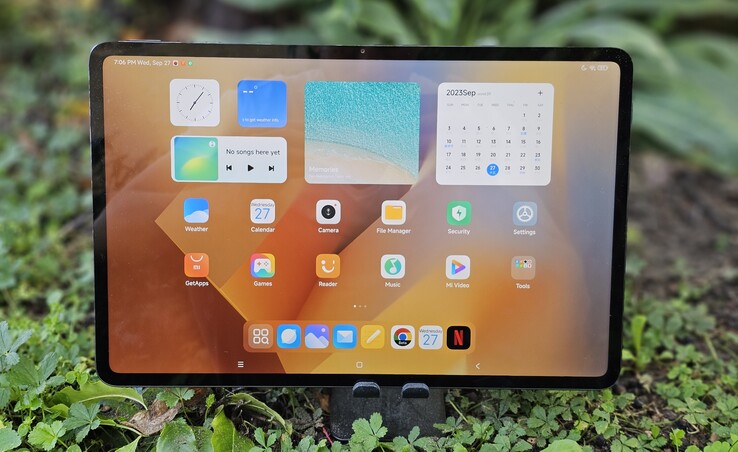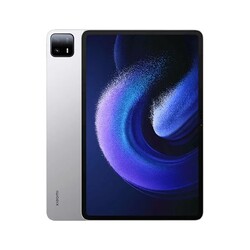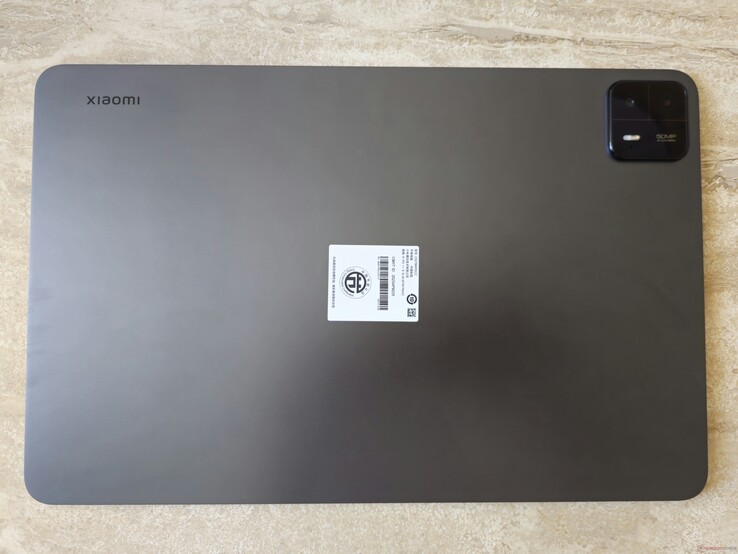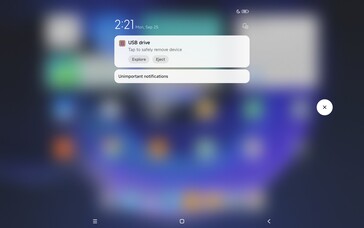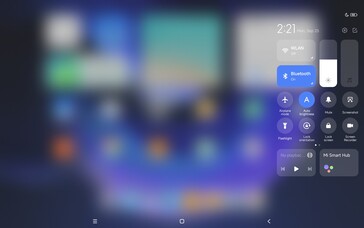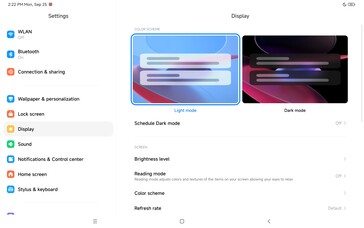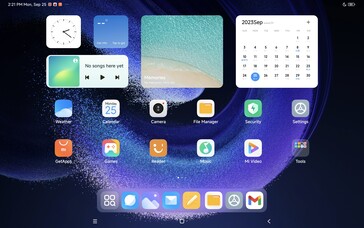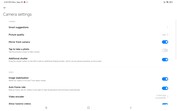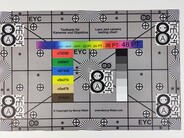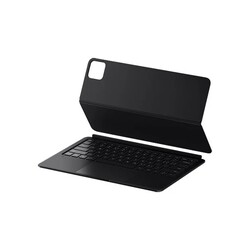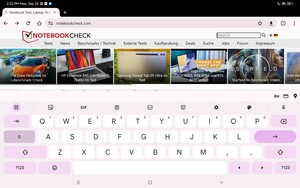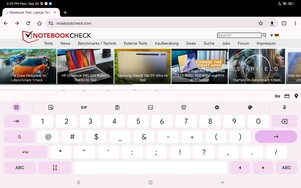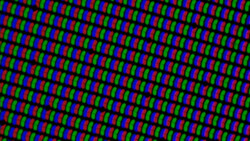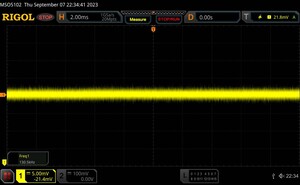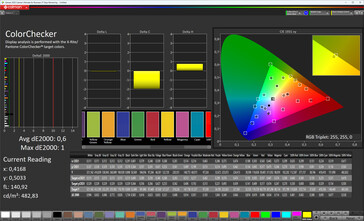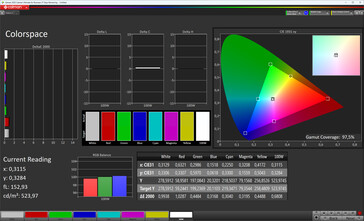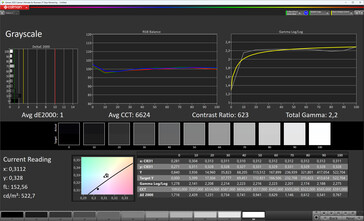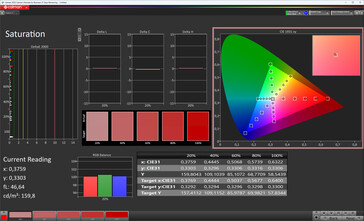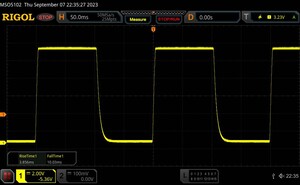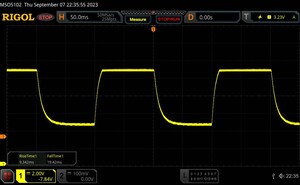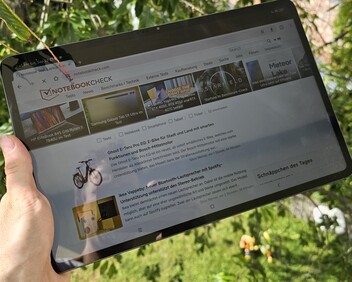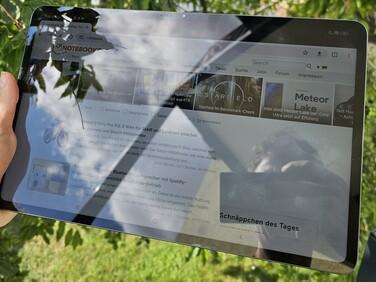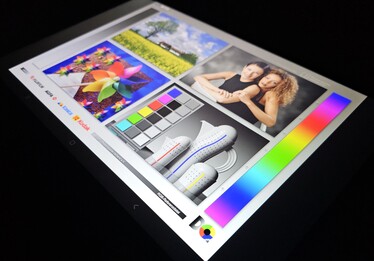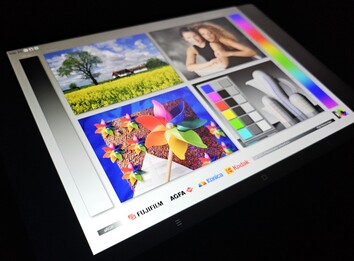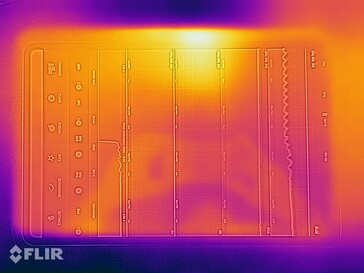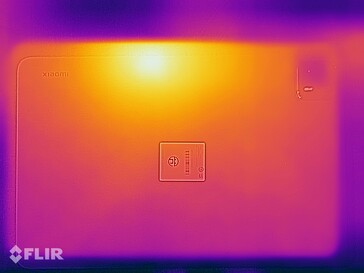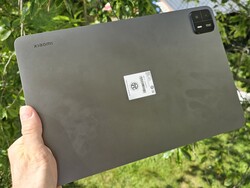Xiaomi Pad 6 Max 14 tablet review - The Samsung Galaxy Tab S9 Ultra alternative for half the price
Fans of big tablets who are looking for an inexpensive alternative to a Samsung Galaxy Tab S9 Ultra or Lenovo Tab Extreme are in for a treat. The Pad 6 Max is Xiaomi's biggest tablet so far, equipped with a 14-inch IPS display with a 120-Hz refresh rate.
The Xiaomi tablet, with its Qualcomm Snapdragon 8+ Gen 1, can be purchased with up to 16 GB RAM and 1 TB UFS 3.1 storage. The base version of the Xiaomi Pad 6 Max features 8 GB DDR5x RAM and 256 GB flash storage and can be found for around US$670 as an import device. It is unlikely that the XXL tablet will have a global launch.
Possible competitors compared
Rating | Date | Model | Weight | Height | Size | Resolution | Price |
|---|---|---|---|---|---|---|---|
| 89.1 % v7 (old) | 09 / 2023 | Xiaomi Pad 6 Max 14 SD 8+ Gen 1, Adreno 730 | 750 g | 6.53 mm | 14.00" | 2880x1800 | |
| 90.6 % v7 (old) | 09 / 2023 | Samsung Galaxy Tab S9 Ultra SD 8 Gen 2 for Galaxy, Adreno 740 | 732 g | 5.5 mm | 14.60" | 2960x1848 | |
| 88.8 % v7 (old) | 08 / 2023 | Lenovo Tab Extreme Dimensity 9000, Mali-G710 MP10 | 740 g | 7.2 mm | 14.50" | 3000x1876 | |
| 91.8 % v7 (old) | 11 / 2022 | Apple iPad Pro 12.9 2022 M2, M2 10-Core GPU | 682 g | 6.4 mm | 12.90" | 2732x2048 |
Case - The Xiaomi tablet featuring Gorilla Glass
Xiaomi hasn't made any big changes to the device's design compared to the Pad 6. The Max version of the tablet features a high-quality feel thanks to its unibody design, even though it is slightly thicker than a Galaxy Tab S9 Ultra. The Pad 6 Max, which has a thickness of 6.53 millimetres and weighs 750 grams, doesn't hold an official IP certification.
The front is made fully from Corning Gorilla Glass 5 which smoothly transitions to the metal frame. The frames on the side of the 14-inch IPS display are moderately sized - this is also reflected in the device's good display-to-size ratio of 87 per cent.
Connectivity - The Xiaomi Pad 6 Max has USB 3.2
The Xiaomi Pad 6 Max has access to a fast USB 3.2 connection (Gen 1). With the help of an adapter, you can also use the port to output picture to external screens. In our copying test using a connected M.2 SSD (Samsung 980 Pro), the USB connection achieved transfer rates of 292 MB/s. The data systems exFAT and NTFS, the latter being preferred by Microsoft systems, are both supported by the Pad 6 Max.
It isn't possible to expand the Xiaomi tablet's storage, so you should keep this in mind when choosing your storage size. However, data can be read via a USB stick if you use the USB Type-C port on the bottom of the tablet. This can be used to play video, for example.
Software - The Xiaomi tablet with Android 13
The Pad 6 Max's operating system is based on Google's Android (version 13) and at the time of testing, the latest security patch was very up to date (September 2023). The manufacturer runs its own MIUI for Pad (version 14) on top. It is unsure for how long the China-exclusive Xiaomi tablet will be supplied with safety updates and Android versions.
As the Pad 6 Max was made exclusively for the Chinese market, the software doesn't support any Google services straight out of the box, and you can only choose between Chinese and English when it comes to system languages. However, you can install all the Google apps including the PlayStore after you have purchased the device.
Communication - The Xiaomi Pad 6 Max features WiFi 6
When connected to your home WLAN, the Xiaomi tablet offers fast WiFi 6 support. This, in combination with our reference router (Asus ROG Rapture GT-AXE11000), resulted in average transfer rates of over 900 MBit/s.
For wireless connections, the tablet supports Bluetooth (version 5.3) - the laptop doesn't feature an NFC chip and you can't purchase a 5G version. The same can be said for a GNSS module.
| Networking | |
| Xiaomi Pad 6 Max 14 | |
| iperf3 receive AXE11000 | |
| iperf3 transmit AXE11000 | |
| Samsung Galaxy Tab S9 Ultra | |
| iperf3 receive AXE11000 | |
| iperf3 transmit AXE11000 | |
| Lenovo Tab Extreme | |
| iperf3 receive AXE11000 | |
| iperf3 transmit AXE11000 | |
| iperf3 transmit AXE11000 6GHz | |
| iperf3 receive AXE11000 6GHz | |
| Apple iPad Pro 12.9 2022 | |
| iperf3 receive AXE11000 | |
| iperf3 transmit AXE11000 | |
| iperf3 transmit AXE11000 6GHz | |
| iperf3 receive AXE11000 6GHz | |
Cameras - The Xiaomi tablet with 50 MPix
The upper frame of the display houses a 20-megapixel front camera. The installed Sony sensor IMX596 with an f/2.2 aperture only allows for video recording in Full HD - compared to its main camera, which features a 4K30 option. Selfies on the Pad 6 Max are a little too smoothed out and its lighting doesn't always work perfectly either.
The back of the Xiaomi tablet features a high-resolution 50-MPix lens with an f/1.8 aperture. It takes good photos for a tablet in this price range, especially in good lighting conditions and using the full resolution. Unfortunately, the pictures lose a bit of sharpness toward the edges and the dynamics could be a little better, too.
Image comparison
Choose a scene and navigate within the first image. One click changes the position on touchscreens. One click on the zoomed-in image opens the original in a new window. The first image shows the scaled photograph of the test device.
Wide-angleWide-angleZoom 5xLow light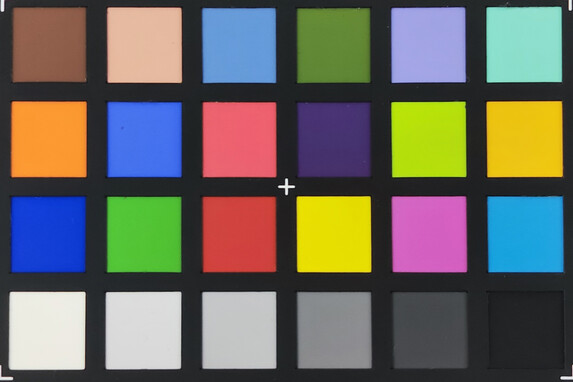

Scope of delivery and warranty - The Xiaomi Pad 6 Max comes with a power supply
The tablet's scope of delivery includes a USB cable and a modular 67-watt power supply with a Type-A connection. Furthermore, TradingShenzhen supplied us with an EU adapter which we required for our test - but this isn't included in the regular scope of delivery. It was just supplied as a service feature of the company that loaned us the device. Xiaomi also offers an optional keyboard case with a trackpad (around US$150 imported) as well as a stylus (around US$ 90 imported) for the mid-range tablet.
The warranty runs for 12 months. With our test device from TradingShenzhen, we also had the option to send the Pad 6 Max to a German address in the event of a warranty claim.
Input devices & operation - The Xiaomi Tablet has FaceUnlock
Finger inputs are recognized very fast on the 14-inch IPS panel. The touchscreen can be operated precisely and animations appear smooth thanks to its 120-Hz refresh rate. Alternatively, the Pad 6 Max can be operated via the stylus, which recognizes 8,192 levels of pressure and tilt.
Unlocking the Xiaomi tablet via its biometric fingerprint recognition is fast and reliable. The position of the on/off button along the left side of the case is a little unusual. You can also authenticate users via facial recognition using the front camera and a ToF sensor. In everyday use and in good lighting conditions, it works very reliably - but it is not that safe (2D method).
Display - The Xiaomi tablet with a 120-Hz refresh rate
The Pad 6 Max has a diagonal length of 14 inches and an aspect ratio of 16:10. The around 35.5-cm IPS panel has a pixel density of 243 PPI and in our measurements, it achieved a maximum brightness of 630 cd/m². Our realistic APL18 measurement, which simulates an even distribution of bright and dark areas on the panel, noted an almost identical value of 628 cd/m². The offered brightness is very good - however, HDR content isn't optimally shown on the certified display.
Under our oscilloscope, we noted constant and high-frequency flickering. Due to its extremely high frequency, this shouldn't be an issue even for PWM-sensitive users.
| |||||||||||||||||||||||||
Brightness Distribution: 85 %
Center on Battery: 630 cd/m²
Contrast: 768:1 (Black: 0.82 cd/m²)
ΔE ColorChecker Calman: 0.6 | ∀{0.5-29.43 Ø4.78}
ΔE Greyscale Calman: 1 | ∀{0.09-98 Ø5}
97.5% sRGB (Calman 2D)
Gamma: 2.2
CCT: 6624 K
| Xiaomi Pad 6 Max 14 IPS LCD, 2880x1800, 14" | Samsung Galaxy Tab S9 Ultra Dynamic AMOLED, 2960x1848, 14.6" | Lenovo Tab Extreme OLED, 3000x1876, 14.5" | Apple iPad Pro 12.9 2022 Mini-LED, 2732x2048, 12.9" | |
|---|---|---|---|---|
| Screen | -103% | -189% | -81% | |
| Brightness middle (cd/m²) | 630 | 621 -1% | 479 -24% | 611 -3% |
| Brightness (cd/m²) | 591 | 620 5% | 456 -23% | 605 2% |
| Brightness Distribution (%) | 85 | 98 15% | 90 6% | 92 8% |
| Black Level * (cd/m²) | 0.82 | |||
| Contrast (:1) | 768 | |||
| Colorchecker dE 2000 * | 0.6 | 1.9 -217% | 3.2 -433% | 1.4 -133% |
| Colorchecker dE 2000 max. * | 1 | 4.6 -360% | 6.82 -582% | 3.3 -230% |
| Greyscale dE 2000 * | 1 | 1.6 -60% | 1.8 -80% | 2.3 -130% |
| Gamma | 2.2 100% | 2.12 104% | 2.28 96% | 2.22 99% |
| CCT | 6624 98% | 6602 98% | 6794 96% | 6930 94% |
* ... smaller is better
Screen Flickering / PWM (Pulse-Width Modulation)
| Screen flickering / PWM detected | 130500 Hz | ||
The display backlight flickers at 130500 Hz (worst case, e.g., utilizing PWM) . The frequency of 130500 Hz is quite high, so most users sensitive to PWM should not notice any flickering. In comparison: 53 % of all tested devices do not use PWM to dim the display. If PWM was detected, an average of 8111 (minimum: 5 - maximum: 343500) Hz was measured. | |||
The Pad 6 Max's color depiction is a little more accurate than on the Pad 6. You can't identify color deviations with your own eye and we measured ideal grayscale DeltaE values(<3). We achieved this color accuracy using the profile "Original Color Pro".
The display's black value isn't as impressive, which only shows an average contrast of under 1:1000. The black value in APL18 was actually even higher, at 0.85 cd/m²
Display Response Times
| ↔ Response Time Black to White | ||
|---|---|---|
| 13.89 ms ... rise ↗ and fall ↘ combined | ↗ 3.856 ms rise | |
| ↘ 10.03 ms fall | ||
| The screen shows good response rates in our tests, but may be too slow for competitive gamers. In comparison, all tested devices range from 0.1 (minimum) to 240 (maximum) ms. » 33 % of all devices are better. This means that the measured response time is better than the average of all tested devices (20.2 ms). | ||
| ↔ Response Time 50% Grey to 80% Grey | ||
| 28.76 ms ... rise ↗ and fall ↘ combined | ↗ 9.342 ms rise | |
| ↘ 19.42 ms fall | ||
| The screen shows relatively slow response rates in our tests and may be too slow for gamers. In comparison, all tested devices range from 0.165 (minimum) to 636 (maximum) ms. » 37 % of all devices are better. This means that the measured response time is similar to the average of all tested devices (31.6 ms). | ||
Outside, you can generally read well from the Xiaomi tablet. If it's really sunny, you might struggle with the screen's legibility a bit, as the Pad 6 Max's maximum brightness may be good, but it doesn't feature enough reserves to overpower reflections.
The screen's viewing-angle stability is excellent, even viewing it at flat angles only leads to a slight loss in brightness. Colors show no inverting whatsoever.
Performance - The Xiaomi tablet features a Qualcomm SoC
The device's powerful Snapdragon 8+ Gen 1 with an Adreno 730 results in good system speed and smooth operation in everyday use. Our benchmark results show the tablet to range on a very strong level and oftentimes, it did even better than a Lenovo Tab Extreme featuring the MediaTek Dimensity 9000. Especially in the offscreen rates of the GFXBench, even the Snapdragon 8 Gen 2 for Galaxy in Samsung's Galaxy Tab S9 Ultra had to admit defeat at times due to the high consistency of the Pad 6 Max.
| AImark - Score v3.x | |
| Average Qualcomm Snapdragon 8+ Gen 1 (887 - 147801, n=11) | |
| Average of class Tablet (138 - 55794, n=53, last 2 years) | |
| Xiaomi Pad 6 Max 14 | |
| Samsung Galaxy Tab S9 Ultra | |
| UL Procyon AI Inference for Android - Overall Score NNAPI | |
| Average Qualcomm Snapdragon 8+ Gen 1 (3291 - 84787, n=21) | |
| Lenovo Tab Extreme | |
| Average of class Tablet (2597 - 76852, n=63, last 2 years) | |
| Samsung Galaxy Tab S9 Ultra | |
| Xiaomi Pad 6 Max 14 | |
GFXBench (DX / GLBenchmark) 2.7: T-Rex Onscreen | 1920x1080 T-Rex Offscreen
GFXBench 3.0: on screen Manhattan Onscreen OGL | 1920x1080 1080p Manhattan Offscreen
GFXBench 3.1: on screen Manhattan ES 3.1 Onscreen | 1920x1080 Manhattan ES 3.1 Offscreen
GFXBench: on screen Car Chase Onscreen | 1920x1080 Car Chase Offscreen | on screen Aztec Ruins High Tier Onscreen | 2560x1440 Aztec Ruins High Tier Offscreen | on screen Aztec Ruins Normal Tier Onscreen | 1920x1080 Aztec Ruins Normal Tier Offscreen | 3840x2160 4K Aztec Ruins High Tier Offscreen
| 3DMark / Wild Life Extreme Unlimited | |
| Apple iPad Pro 12.9 2022 | |
| Samsung Galaxy Tab S9 Ultra | |
| Xiaomi Pad 6 Max 14 | |
| Lenovo Tab Extreme | |
| 3DMark / Wild Life Extreme | |
| Apple iPad Pro 12.9 2022 | |
| Samsung Galaxy Tab S9 Ultra | |
| Xiaomi Pad 6 Max 14 | |
| Lenovo Tab Extreme | |
| 3DMark / Wild Life Unlimited Score | |
| Apple iPad Pro 12.9 2022 | |
| Samsung Galaxy Tab S9 Ultra | |
| Xiaomi Pad 6 Max 14 | |
| Lenovo Tab Extreme | |
| 3DMark / Wild Life Score | |
| Lenovo Tab Extreme | |
| Apple iPad Pro 12.9 2022 | |
| 3DMark / Sling Shot Extreme (ES 3.1) Unlimited | |
| Samsung Galaxy Tab S9 Ultra | |
| Xiaomi Pad 6 Max 14 | |
| 3DMark / Sling Shot Extreme (ES 3.1) Unlimited Graphics | |
| Samsung Galaxy Tab S9 Ultra | |
| Xiaomi Pad 6 Max 14 | |
| 3DMark / Sling Shot Extreme (ES 3.1) Unlimited Physics | |
| Samsung Galaxy Tab S9 Ultra | |
| Xiaomi Pad 6 Max 14 | |
| GFXBench (DX / GLBenchmark) 2.7 / T-Rex Onscreen | |
| Apple iPad Pro 12.9 2022 | |
| Samsung Galaxy Tab S9 Ultra | |
| Xiaomi Pad 6 Max 14 | |
| Lenovo Tab Extreme | |
| GFXBench (DX / GLBenchmark) 2.7 / T-Rex Offscreen | |
| Apple iPad Pro 12.9 2022 | |
| Xiaomi Pad 6 Max 14 | |
| Samsung Galaxy Tab S9 Ultra | |
| Lenovo Tab Extreme | |
| GFXBench 3.0 / Manhattan Onscreen OGL | |
| Apple iPad Pro 12.9 2022 | |
| Xiaomi Pad 6 Max 14 | |
| Samsung Galaxy Tab S9 Ultra | |
| Lenovo Tab Extreme | |
| GFXBench 3.0 / 1080p Manhattan Offscreen | |
| Apple iPad Pro 12.9 2022 | |
| Xiaomi Pad 6 Max 14 | |
| Samsung Galaxy Tab S9 Ultra | |
| Lenovo Tab Extreme | |
| GFXBench 3.1 / Manhattan ES 3.1 Onscreen | |
| Apple iPad Pro 12.9 2022 | |
| Xiaomi Pad 6 Max 14 | |
| Samsung Galaxy Tab S9 Ultra | |
| Lenovo Tab Extreme | |
| GFXBench 3.1 / Manhattan ES 3.1 Offscreen | |
| Apple iPad Pro 12.9 2022 | |
| Xiaomi Pad 6 Max 14 | |
| Samsung Galaxy Tab S9 Ultra | |
| Lenovo Tab Extreme | |
| GFXBench / Car Chase Onscreen | |
| Apple iPad Pro 12.9 2022 | |
| Samsung Galaxy Tab S9 Ultra | |
| Xiaomi Pad 6 Max 14 | |
| Lenovo Tab Extreme | |
| GFXBench / Car Chase Offscreen | |
| Apple iPad Pro 12.9 2022 | |
| Samsung Galaxy Tab S9 Ultra | |
| Xiaomi Pad 6 Max 14 | |
| Lenovo Tab Extreme | |
| GFXBench / Aztec Ruins High Tier Onscreen | |
| Apple iPad Pro 12.9 2022 | |
| Samsung Galaxy Tab S9 Ultra | |
| Xiaomi Pad 6 Max 14 | |
| Lenovo Tab Extreme | |
| GFXBench / Aztec Ruins High Tier Offscreen | |
| Apple iPad Pro 12.9 2022 | |
| Samsung Galaxy Tab S9 Ultra | |
| Xiaomi Pad 6 Max 14 | |
| Lenovo Tab Extreme | |
| GFXBench / Aztec Ruins Normal Tier Onscreen | |
| Apple iPad Pro 12.9 2022 | |
| Samsung Galaxy Tab S9 Ultra | |
| Xiaomi Pad 6 Max 14 | |
| Lenovo Tab Extreme | |
| GFXBench / Aztec Ruins Normal Tier Offscreen | |
| Apple iPad Pro 12.9 2022 | |
| Samsung Galaxy Tab S9 Ultra | |
| Xiaomi Pad 6 Max 14 | |
| Lenovo Tab Extreme | |
| GFXBench / 4K Aztec Ruins High Tier Offscreen | |
| Apple iPad Pro 12.9 2022 | |
| Samsung Galaxy Tab S9 Ultra | |
| Xiaomi Pad 6 Max 14 | |
| Lenovo Tab Extreme | |
| Jetstream 2 - 2.0 Total Score | |
| Apple iPad Pro 12.9 2022 (Safari Mobile 16.1) | |
| Samsung Galaxy Tab S9 Ultra (Chrome 116) | |
| Average of class Tablet (22.3 - 395, n=68, last 2 years) | |
| Lenovo Tab Extreme (Chrome 115) | |
| Average Qualcomm Snapdragon 8+ Gen 1 (76.2 - 204, n=23) | |
| Xiaomi Pad 6 Max 14 (Mi Browser V14) | |
| WebXPRT 4 - Overall | |
| Apple iPad Pro 12.9 2022 (Safari Mobile 16.1) | |
| Samsung Galaxy Tab S9 Ultra (Chrome 116) | |
| Average of class Tablet (26 - 376, n=72, last 2 years) | |
| Average Qualcomm Snapdragon 8+ Gen 1 (69 - 159, n=21) | |
| Lenovo Tab Extreme (Chrome 115) | |
| Xiaomi Pad 6 Max 14 (Mi Browser V14) | |
| Octane V2 - Total Score | |
| Apple iPad Pro 12.9 2022 (Safari Mobile 16.1) | |
| Samsung Galaxy Tab S9 Ultra (Chrome 116) | |
| Lenovo Tab Extreme (Chrome 115) | |
| Average of class Tablet (763 - 138481, n=96, last 2 years) | |
| Average Qualcomm Snapdragon 8+ Gen 1 (17622 - 61536, n=24) | |
| Xiaomi Pad 6 Max 14 (Mi Browser V14) | |
| Mozilla Kraken 1.1 - Total | |
| Average of class Tablet (243 - 27101, n=81, last 2 years) | |
| Xiaomi Pad 6 Max 14 (Mi Browser V14) | |
| Lenovo Tab Extreme (Chrome 115) | |
| Average Qualcomm Snapdragon 8+ Gen 1 (665 - 1707, n=22) | |
| Samsung Galaxy Tab S9 Ultra (Chrome 116) | |
| Apple iPad Pro 12.9 2022 (Safari Mobile 16.1) | |
* ... smaller is better
| Xiaomi Pad 6 Max 14 | Samsung Galaxy Tab S9 Ultra | Lenovo Tab Extreme | Average 256 GB UFS 3.1 Flash | Average of class Tablet | |
|---|---|---|---|---|---|
| AndroBench 3-5 | 8% | -11% | -25% | -28% | |
| Sequential Read 256KB (MB/s) | 1983.47 | 3367.33 70% | 1914.4 -3% | 1757 ? -11% | 1786 ? -10% |
| Sequential Write 256KB (MB/s) | 1873.45 | 1891.49 1% | 1585 -15% | 1204 ? -36% | 1334 ? -29% |
| Random Read 4KB (MB/s) | 374.54 | 449.37 20% | 330.7 -12% | 287 ? -23% | 244 ? -35% |
| Random Write 4KB (MB/s) | 446.71 | 174.32 -61% | 380.6 -15% | 318 ? -29% | 278 ? -38% |
Emissions - The Xiaomi tablet isn't throttled
Temperature
The Xiaomi tablet's case barely gets warm in everyday use and even under load, its temperatures never increase drastically. In order to check the heat behavior inside the device, we used 3DMark. The Wild Life stress tests ran perfectly with a consistency of over 99 per cent. Interestingly, the Pad 6 Max had about the same performance level as the Samsung Galaxy Tab S9 Ultra with the Snapdragon 8 Gen 2 after about half of the runs.
(±) The maximum temperature on the upper side is 44.1 °C / 111 F, compared to the average of 33.7 °C / 93 F, ranging from 20.7 to 53.2 °C for the class Tablet.
(±) The bottom heats up to a maximum of 44 °C / 111 F, compared to the average of 33.2 °C / 92 F
(+) In idle usage, the average temperature for the upper side is 31.1 °C / 88 F, compared to the device average of 30 °C / 86 F.
3DMark Wild Life Stress Test
| 3DMark | |
| Wild Life Extreme Stress Test | |
| Xiaomi Pad 6 Max 14 | |
| Lenovo Tab Extreme | |
| Samsung Galaxy Tab S9 Ultra | |
| Wild Life Stress Test Stability | |
| Xiaomi Pad 6 Max 14 | |
| Lenovo Tab Extreme | |
| Samsung Galaxy Tab S9 Ultra | |
Speakers
The tablet's eight stereo speakers consisting of four woofers and tweeters provide a very good sound experience. Basses are not audible for the most part, but the Pad 6 Max impresses with powerful lows and even mids. The trebles are also emphasized very well.
Some users will miss the lack of a 3.5 mm audio output on a tablet. Instead, audio content has to be output via the USB-C port using an adapter. Wirelessly, a wide range of audio codecs is available via Bluetooth 5.3: SBC, AAC, aptX, aptX HD, aptX Adaptive as well as LDAC and LHDC (V5).
Xiaomi Pad 6 Max 14 audio analysis
(+) | speakers can play relatively loud (88.2 dB)
Bass 100 - 315 Hz
(±) | reduced bass - on average 13.3% lower than median
(±) | linearity of bass is average (8.8% delta to prev. frequency)
Mids 400 - 2000 Hz
(+) | balanced mids - only 3.5% away from median
(+) | mids are linear (3.7% delta to prev. frequency)
Highs 2 - 16 kHz
(+) | balanced highs - only 2.2% away from median
(+) | highs are linear (4.8% delta to prev. frequency)
Overall 100 - 16.000 Hz
(+) | overall sound is linear (9.9% difference to median)
Compared to same class
» 5% of all tested devices in this class were better, 3% similar, 92% worse
» The best had a delta of 7%, average was 20%, worst was 129%
Compared to all devices tested
» 4% of all tested devices were better, 1% similar, 95% worse
» The best had a delta of 4%, average was 24%, worst was 134%
Apple iPad Pro 12.9 2022 audio analysis
(+) | speakers can play relatively loud (84.3 dB)
Bass 100 - 315 Hz
(±) | reduced bass - on average 9.6% lower than median
(±) | linearity of bass is average (9% delta to prev. frequency)
Mids 400 - 2000 Hz
(+) | balanced mids - only 2.4% away from median
(+) | mids are linear (3.4% delta to prev. frequency)
Highs 2 - 16 kHz
(+) | balanced highs - only 1.5% away from median
(+) | highs are linear (3.2% delta to prev. frequency)
Overall 100 - 16.000 Hz
(+) | overall sound is linear (8.8% difference to median)
Compared to same class
» 2% of all tested devices in this class were better, 2% similar, 96% worse
» The best had a delta of 7%, average was 20%, worst was 129%
Compared to all devices tested
» 2% of all tested devices were better, 1% similar, 97% worse
» The best had a delta of 4%, average was 24%, worst was 134%
Power management - The Xiaomi Pad 6 Max has Fast Charging
Power consumption
The Pad 6 Max can be charged at 67 watts, but it is also possible to connect smartphones to the tablet's USB port and to charge them at up to 33 watts. In idle mode, its consumption isn't the most efficient.
| Off / Standby | |
| Idle | |
| Load |
|
Key:
min: | |
| Xiaomi Pad 6 Max 14 10000 mAh | Samsung Galaxy Tab S9 Ultra 11200 mAh | Lenovo Tab Extreme 12300 mAh | Apple iPad Pro 12.9 2022 10702 mAh | |
|---|---|---|---|---|
| Power Consumption | 15% | 30% | -12% | |
| Idle Minimum * (Watt) | 2.57 | 3.17 -23% | 2.6 -1% | 2.54 1% |
| Idle Average * (Watt) | 8.65 | 3.68 57% | 3 65% | 11.24 -30% |
| Idle Maximum * (Watt) | 8.71 | 3.91 55% | 3.4 61% | 11.48 -32% |
| Load Average * (Watt) | 14.98 | 15.83 -6% | 9.5 37% | 12.97 13% |
| Load Maximum * (Watt) | 14.99 | 15.84 -6% | 16.9 -13% | 16.6 -11% |
* ... smaller is better
Power consumption: Geekbench (150 cd/m²)
Power consumption: GFXBench (150 cd/m²)
Runtimes
The Pad 6 Max lasted a very long 15 hours in our Wi-Fi test with an adjusted display brightness of 150 cd/m². Its 10,000 mAh battery is charged very quickly in about 80 minutes when using the included charger.
| Xiaomi Pad 6 Max 14 10000 mAh | Samsung Galaxy Tab S9 Ultra 11200 mAh | Lenovo Tab Extreme 12300 mAh | Apple iPad Pro 12.9 2022 10702 mAh | |
|---|---|---|---|---|
| Battery runtime | ||||
| WiFi v1.3 (h) | 15 | 10.4 -31% | 11.1 -26% | 11.2 -25% |
Pros
Cons
Verdict on the Xiaomi Pad 6 Max
The Xiaomi Pad 6 Max offers a lot for its money, even though interested buyers will have to live with the usual issues that arise from purchasing an import device (no native GMS, limited language options, ...). Compared to its XXL tablet competition, the Xiaomi Tab benefits from long runtimes - even an iPad Pro 12.9 can't keep up. No compromises have to be made when it comes to its quality and audio experience either.
Its installed Snapdragon 8+ Gen 1 may not be Qualcomm's most current high-end SoC, however, it has enough reserves to provide smooth everyday use - and even a considerably more expensive Lenovo Tab Extreme did worse in our benchmark tests. Furthermore, the Xiaomi tablet even manages to perform similarly to a Galaxy Tab S9 Ultra under load, thanks to its good system cooling and consistent power delivery.
If you are interested in buying an XXL tablet and aren't prepared to spend US$1,000, then the Xiaomi Pad 6 Max might be a really interesting alternative.
The Chinese manufacturer has saved a bit of money when it comes to the device's connectivity. It features neither 5G nor GPS support. Another weakness of the Pad 6 Max is the high black value on its otherwise good IPS panel.
Price and availability
The Xiaomi Pad 6 Max is available for around US$670 and can be purchased from websites such as Trading Shenzhen.
Xiaomi Pad 6 Max 14
- 09/27/2023 v7 (old)
Marcus Herbrich
Transparency
The selection of devices to be reviewed is made by our editorial team. The test sample was provided to the author as a loan by the manufacturer or retailer for the purpose of this review. The lender had no influence on this review, nor did the manufacturer receive a copy of this review before publication. There was no obligation to publish this review. As an independent media company, Notebookcheck is not subjected to the authority of manufacturers, retailers or publishers.
This is how Notebookcheck is testing
Every year, Notebookcheck independently reviews hundreds of laptops and smartphones using standardized procedures to ensure that all results are comparable. We have continuously developed our test methods for around 20 years and set industry standards in the process. In our test labs, high-quality measuring equipment is utilized by experienced technicians and editors. These tests involve a multi-stage validation process. Our complex rating system is based on hundreds of well-founded measurements and benchmarks, which maintains objectivity. Further information on our test methods can be found here.




